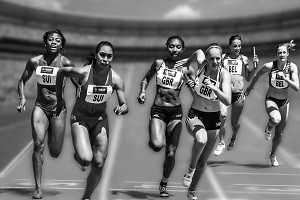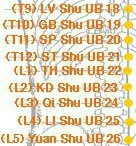Basic Tools In The Treatment Of Sports Injuries With Acupuncture

Chinese Medicine has a long history of treating traumatic physical injuries and generally is quite effective at resolving these issues. There are many other issues that athletes may develop besides tight muscles and there are many treatment methods that acupuncturists may use to aid the recovery from these injuries. Within this article, which is an extension of my previous article on motor points, I aim to explore some of these techniques.
Sports Injuries
First, I want to mention some of the more common sports injuries. These injuries are not, of course, experienced exclusively by atheletes; they can be work-related, from a car accident or any other means of injury.
Muscle hypertonicity - muscle tension or basically tightness of the muscles. It can be caused by overuse of the muscles or from injury.
Disc injuries - discs are located between vertebrae in the spinal column and are commonly injured, they can be herniated or bulging. Some of the disc injuries can cause pain radiating down the arm or leg depending on where the disc injury is located.
Tendonitis - inflammation of the tendons which are what connects muscles to the bone, the common injury is lateral epicondylitis or commonly known as tennis elbow.
Muscle strain - pulled muscle, where there is micro-tearing of the muscles or in some large tearing.
Sprain - injury to joints capsule and ligaments, a common one is an ankle sprain.
Overuse injuries - these the injuries from overuse of the muscle or joint, a common one is tennis elbow.
Treatment Methods
Motor Point Acupuncture
This set of points and techniques are explained in my previous blog article, but here is a quick rundown of motor points. Motor points are a somewhat new technique combined with an already existing network of acupuncture meridians and points; however, some of the motor points are not on acupuncture meridians or are not acupuncture points, and some of them slightly close to some of the acupuncture points. There are about 128 mapped out motor points on the body.
The easy explanation for what motor points may accomplish is that they release hypertonic or tight muscles and strengthen weak skeletal muscles, basically, the muscle gets restarted to function properly, it’s like a little restart button for muscles. The more scientific explanation is that motor points are an entrance site of the motor nerves into the muscle where acupuncture needle can be used to retrain neuromuscular function that has been lost due to an injury. With this way of acupuncture, musculoskeletal issue patients may heal more quickly and may develop increased range of motion, may regain muscle strength, and may have improved ADLs (activities of daily living) more efficiently than with just regular acupuncture. More about motor points can be read in Matt Callison’s Motor Point Index book.
Other potentially helpful techniques are as follows:
GuaSha
GuaSha or IASTM (Instrument Assisted Soft Tissue Mobilization) are tools that help the practitioner locate and treat a wide array of soft tissue dysfunctions caused by adhesions in the soft tissue. These tools break down fascial restrictions and scar tissue. Tools are made from materials such as stainless steel, wood, ceramics, horn, plastic, jade, etc. Basically what these tools do is they break down fascial restrictions and scar tissue by creating microtrauma and local inflammation in the area, increases blood flow and maintains optimal movement and range of motion.
Cupping
Cupping is the term applied to a technique that uses small glass cups or bamboo jars as suction devices that are placed directly on the skin. Suction can be created by placing an inverted glass cup over a small flame. Once the suction has occurred, the cups can be gently moved across the skin (often referred to as moving cupping) or cups can also be left in place for about 10 minutes while the patient relaxes, known as stationary cupping. Suction and negative pressure provided by cupping can loosen muscles, and encourage blood flow. Cupping is commonly used to relieve back and neck pain, relaxes tight muscles and affects tissues up to four inches deep from the external skin. (For more see "What is Cupping?")
TuiNa
Chinese medicine bodywork or therapeutic massage. Tui means pushing, and Na means grasping. More special definition of TuiNa - not just pushing and grasping but various manipulations working on certain parts (channels/meridians, points, muscle regions) of the body to treat or prevent the disease/illness, relax muscles and alleviate pain.
Liniments and Oils
Liniments and medicated oils are a great addition to the above treatment modalities and add extra to treatment and speed up the healing process. Below I will mention some of the commonly used ones in practice that I have used before or still use.
Die Da Wan Hua Oil - great oil for slide cupping and GuaSha, this famous herbal medicated oil is used to temporarily relieve aches and pains in muscles and joints.
Po Sum On Oil - this oil is for temporary relief of minor aches and pains of muscles and joints due to a simple backache, arthritis, strains, bruises, and sprains. It can also be used for abdominal pain caused by being exposed to cold wind or cold environment.
Kwan Loong/White Flower Oil - this oil is used for temporary relief of minor aches and pains of muscles and joints due to a simple backache, arthritis, strains, bruises, sprains.
Zheng Gu Shui - this oil is used for pain in muscles and joints and also for bone hardening for those in martial arts. This is also the liniment of choice for bone fractures and works great on bruises.
Clinical Example - Research
Below is one study, of many, that show the effectiveness of some of the aforementioned treatment methods; in this case cupping.
In the study they looked at the effects of moving cupping (also known as "sliding" cupping) on non-specific low back pain, they divided 70 patients into two groups, a moving cupping study group that consisted of 37 patients, and a dexibuprofen (NSAID) control group that consisted of 33 patients. Both groups were treated for 12 days, the moving cupping group received treatment every other day with 6 treatments in total, and the western NSAID group received a dosage of 0.15g three times a day. The researchers found that those patients in the moving cupping group had a greater reduction in symptoms than the NSAID treatment group. Overall moving cupping had an effective rate of 91.9% vs dexibuprofen control group 75.8%.
Clinical Example - Case Study
Here is one of my own cases of sports injury patient care. The patient is a 28-year-old male, competitive long distance runner, runs 70 miles per week. He was treated 2 times during his first week here, and then once weekly for two more weeks. On the initial visit he reported right pain in the SI joint, piriformis, and low back; aggravated with running. Palpation revealed hypertonic right piriformis and right lumbar erectors, right SI joint was tender on palpation. I then used the following acupuncture points:
 UB 23 - local point in this case, but also a major strenghtening point of the "kidney" system which influences bone health, deeper vitality, etc. (see "My Kidneys Are What?" for general information on the "kidneys" in Chinese Medicine terms).
UB 23 - local point in this case, but also a major strenghtening point of the "kidney" system which influences bone health, deeper vitality, etc. (see "My Kidneys Are What?" for general information on the "kidneys" in Chinese Medicine terms).- UB 26 - local point for back pain.
- GB 30 - Important point for sciatica, general low back pain, and arthritis in the back and/or legs.
- UB 40 - Important point for pain the lower back as well as summer heat related issues such as heat exhaustion.
- SP 6 - Strenghtens the "yin" of the body - which in this case is to direct the body to better nourish the tendons with fluids.
- and ashi ("local/ouch") points at the right piriformis, buttocks, SI joint and lumbar erectors.
TuiNa was performed on whole back and bilateral piriformis muscles.
On his second visit he reported that pain and muscle tightness have decreased dramatically after the initial treatment. He also reported that when making a step on the stairs he feels pain shoots from right SI joint to right lumbar erectors. Palpation revealed less hypertonicity in right piriformis and lumbar erectors than on the first visit. Similar acupuncture points were done on this visit. Cupping was done on bilateral piriformis and lumbar erectors, and TuiNa on whole back and bilateral piriformis muscles.
On the third visit he reported feeling great, the day before the visit was the first day that he was able to walk pain-free. Palpation revealed slight hypertonicity in right TFL only, no hypertonicity in piriformis and lumbar erectors. Similar acupuncture points were used with cupping in piriformis, TFL and lumbar erectors, with TuiNa at the end of visit.
On the fourth visit he stated that he started running, ran for two days and had no pain with running. No hypertonic muscles were found on this visit. Similar acupuncture points were used with cupping and TuiNa. The patient is scheduled to be seen in three weeks for maintenance treatment.
Conclusion
There are many different ways to go about treating sports injuries in acupuncture practice. Besides using acupuncture or motor point acupuncture we can do TuiNa, cupping, GuaSha, and use a variety of different liniments and oils to enhance the healing of injuries. Each practitioner will choose what techniques to use based on the needs of the patient at that time, but the reservoir is deep within Chinese Medicine.
tag @yinyanghouse for questions/comments